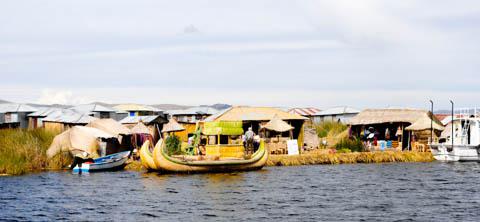Traveling in Lake Titicaca (Puno)
 Lake Titicaca, Peru
Lake Titicaca, Peru
Lake Titicaca, which directly translates to "puma stone" in Quechua, is located high in the Andes Mountains straddling Peru and Bolivia, with about 60% of the lake in Peru and 40% in Bolivia. Among the lake are three main islands, the most popular of which are the Uros Islands, also known as the floating islands, where the Uros people live on totora reeds that grow in the lake.
Known as the highest navigable lake in the world, Lake Titicaca sits at 12,507 feet and covers a little more than 3,200 square miles.
With that elevation, the most difficult part about visiting the area may very well be the altitude. Unless you are acclimated to the mountains, you'll likely experience symptoms of altitude sickness, such as headaches, dizziness, indigestion, and/or insomnia.
If you are unable to acclimate after a few days, it's best to descend to a lower elevation and try again later, and more slowly. You can also opt to take Diamox (a prescription pill which you can buy in the U.S.) 24 hours before arriving at the altitude, drop chlorophyll drops to drink in your water, chew coca leaves, and drink mate de coca (coca tea). Above all, it's important to take it easy and not overexert yourself until you've acclimated. Some hotels also offer oxygen tanks for those who are unable to handle the change in altitude so quickly.
Lake Titicaca is wettest in the month of November and experiences heavy rainfall all throughout January. Visit between May and September for average highs in the 80s and evening lows in the 40s.

 Budget Your Trip is all about finding out how much everything costs so that you can travel cheaper and longer. Created by avid travelers Laurie and Bryan, our goal is to help you plan your next trip on the right budget. With average daily travel costs that are calculated from the budgets of real travelers, plus an analysis of hotel and tour prices, you can find out how much money you need to plan your next adventure. We also have plenty of travel advice, accommodation reviews, and activity suggestions.
Budget Your Trip is all about finding out how much everything costs so that you can travel cheaper and longer. Created by avid travelers Laurie and Bryan, our goal is to help you plan your next trip on the right budget. With average daily travel costs that are calculated from the budgets of real travelers, plus an analysis of hotel and tour prices, you can find out how much money you need to plan your next adventure. We also have plenty of travel advice, accommodation reviews, and activity suggestions.